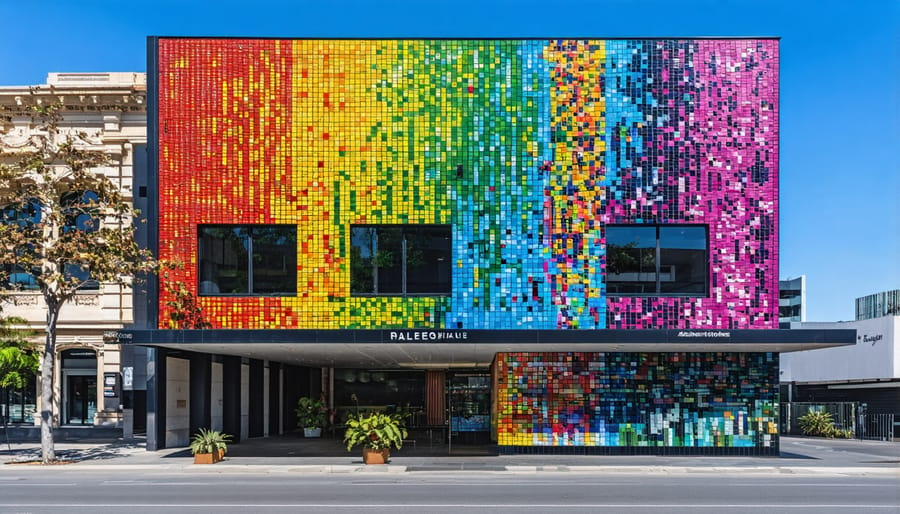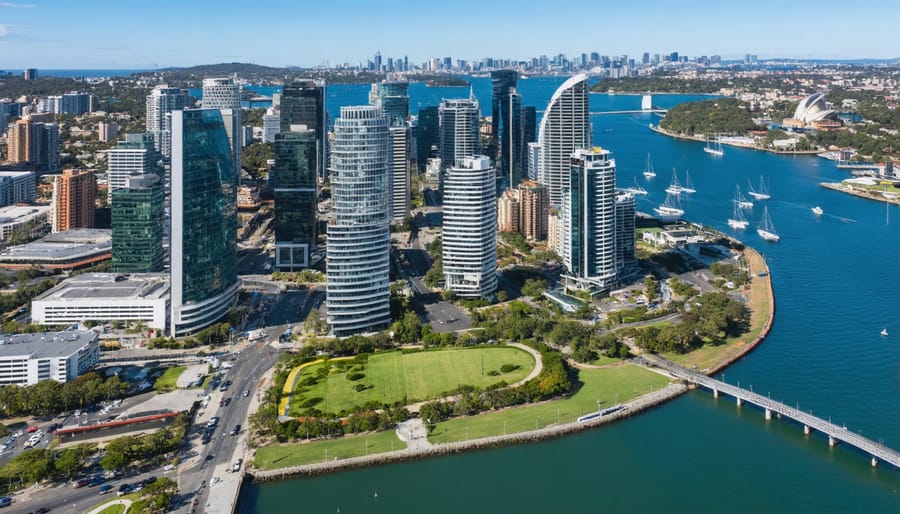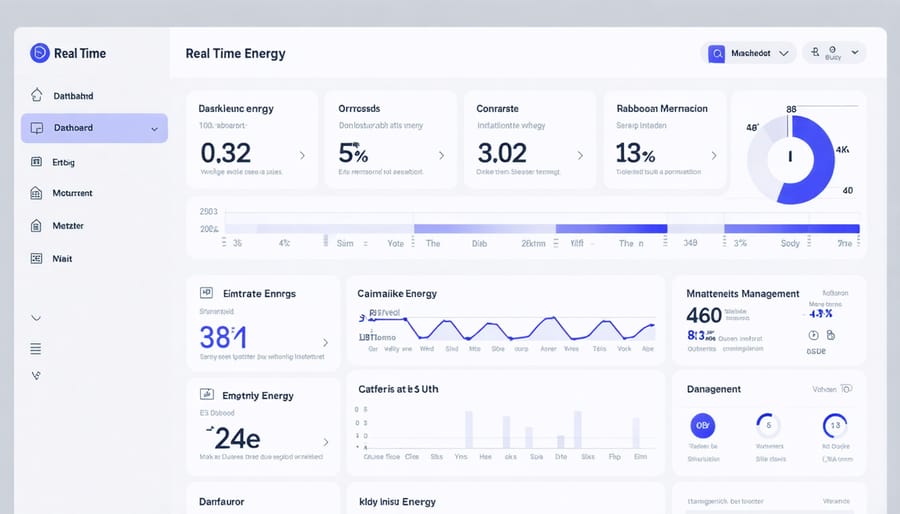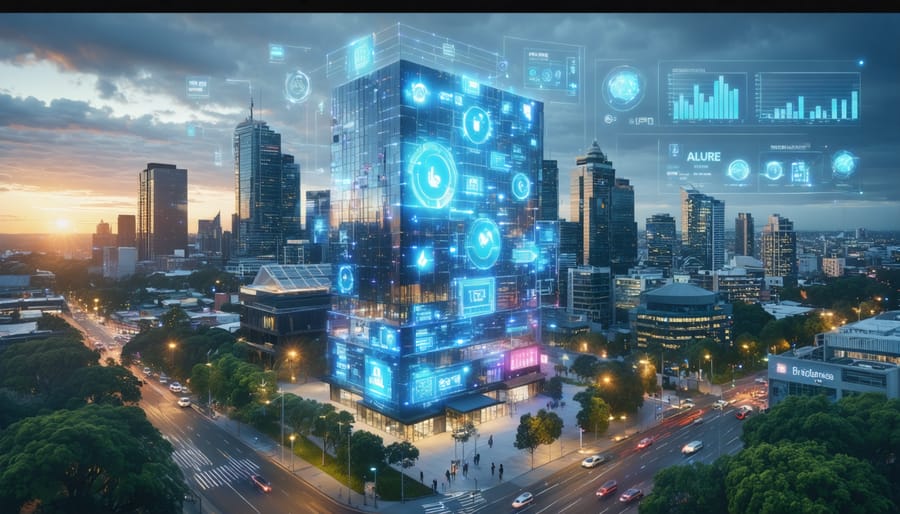Step inside Australia’s most innovative smart building energy systems, where cutting-edge technology transforms ordinary structures into intelligent, sustainable powerhouses. From Melbourne’s Pixel Building, achieving a perfect 105 Green Star rating with its self-adjusting solar panels and water recycling systems, to Sydney’s EY Centre with its revolutionary timber-and-glass facade that responds to sunlight, these architectural marvels showcase the future of sustainable urban development.
These buildings don’t just impress – they perform. Brisbane’s 480 Queen Street demonstrates how smart buildings slash energy consumption by 40% through AI-powered climate control and automated lighting systems. Meanwhile, Perth’s Brookfield Place proves that heritage buildings can embrace smart technology, using advanced building management systems to optimize everything from elevator operations to waste management.
Smart buildings represent more than technological achievement; they’re blueprints for a sustainable future where buildings adapt to occupant needs while minimizing environmental impact. As Australia leads the charge in smart building innovation, these examples demonstrate how intelligent design, sustainable practices, and cutting-edge technology converge to create spaces that work smarter, not harder.

How Melbourne’s Pixel Building Revolutionized Smart Energy Management
Real-Time Energy Monitoring Systems
Modern smart buildings are leading the charge in transforming Australia’s energy future through sophisticated real-time energy monitoring systems. These cutting-edge solutions provide building managers with unprecedented visibility into energy consumption patterns and operational efficiency.
At the heart of these systems are networks of smart sensors strategically placed throughout the building. These sensors continuously collect data on electricity usage, heating and cooling demands, lighting levels, and occupancy patterns. The information feeds into centralized building management systems that use artificial intelligence to optimize energy usage automatically.
For instance, when sensors detect that a meeting room is empty, the system automatically adjusts the temperature and dims the lights. During peak sunshine hours, smart blinds adjust to reduce cooling needs while maintaining optimal natural light levels. The system even learns from historical data to predict and prepare for upcoming energy demands based on weather forecasts and building usage patterns.
Building occupants can access real-time energy data through user-friendly dashboards and mobile apps, encouraging energy-conscious behaviour. These monitoring systems typically achieve energy savings of 20-30% compared to conventional buildings, while also improving comfort levels and reducing maintenance costs through predictive analytics.
The real power lies in the system’s ability to make split-second decisions, balancing energy efficiency with occupant comfort, and automatically reporting any anomalies that might indicate equipment issues or energy waste.
Adaptive Lighting and Climate Control
Modern smart buildings are revolutionising the way we manage lighting and climate control through sophisticated sensor networks and AI-driven systems. At Melbourne’s Pixel Building, occupancy sensors automatically adjust lighting levels based on natural daylight and human presence, reducing energy consumption by up to 45%. The building’s smart HVAC system uses predictive analytics to anticipate temperature changes, maintaining optimal comfort while minimising energy usage.
In Sydney’s International Towers, smart lighting systems integrate with automated blinds to harvest natural daylight effectively. When sunshine is abundant, the blinds adjust their position while indoor lighting dims accordingly. The system also learns from occupant behaviour patterns, automatically creating comfort zones based on individual preferences and work schedules.
Brisbane’s 480 Queen Street showcases how adaptive climate control can respond to Queensland’s subtropical climate. Its smart HVAC system analyses weather forecasts, indoor air quality, and occupancy patterns to optimise temperature settings throughout the day. During peak heat periods, the system pre-cools specific zones before occupants arrive, reducing energy strain during high-demand periods.
These systems communicate through centralised building management platforms, enabling facility managers to monitor performance in real-time and make data-driven decisions. The result is a perfect balance between occupant comfort and energy efficiency, with some buildings reporting energy savings of up to 30% compared to conventional systems.
Sydney’s Barangaroo: Australia’s Largest Carbon-Neutral Precinct

Centralized Energy Management Hub
At the heart of modern smart buildings lies the Centralized Energy Management Hub, a sophisticated command centre that orchestrates the entire building’s energy ecosystem. This cutting-edge system serves as the building’s brain, continuously monitoring and optimizing energy consumption across all facilities and systems.
The hub collects real-time data from thousands of sensors strategically placed throughout the building, tracking everything from occupancy patterns to temperature fluctuations and lighting levels. Advanced algorithms process this information to make instant adjustments, ensuring optimal energy usage while maintaining occupant comfort.
In practice, the system might detect that a particular floor is empty during lunch hours and automatically adjust the HVAC settings and lighting accordingly. When employees return, the system seamlessly restores comfort levels before they even notice any change. This predictive capability helps buildings reduce energy waste while enhancing user experience.
The dashboard interface provides facility managers with comprehensive insights through intuitive visualizations. They can monitor energy consumption patterns, identify inefficiencies, and implement improvements based on data-driven decisions. For instance, the system might reveal that certain meeting rooms are overcooled during morning hours, prompting adjustments to temperature settings that save energy without compromising comfort.
Integration with renewable energy sources adds another layer of sophistication. The hub can automatically switch between grid power and on-site solar generation based on availability and demand, while also managing energy storage systems to maximize cost savings during peak pricing periods.
What sets modern energy management hubs apart is their ability to learn and adapt over time, continuously refining their operation to achieve ever-greater efficiency gains.
Renewable Integration Success
Leading Australian smart buildings are setting new benchmarks in renewable energy integration, demonstrating how innovative design and technology can create truly sustainable urban spaces. The Melbourne Quarter precinct showcases exemplary solar integration, with its extensive rooftop solar array generating up to 450 MWh annually – enough to power 70% of the building’s common areas.
Sydney’s International Towers have revolutionized waste energy integration through their advanced waste-to-energy systems, converting organic waste from food courts and offices into biogas that supplements the building’s power needs. This circular approach reduces landfill waste while generating clean energy.
Brisbane’s 480 Queen Street building demonstrates how smart technology can optimize renewable energy use. Its intelligent building management system continuously monitors energy consumption and automatically adjusts solar panel orientation to maximize energy capture. The system also manages energy storage, ensuring surplus power is available during peak demand periods.
The success of these integrations relies heavily on sophisticated monitoring and control systems. Real-time data analytics help facility managers track energy production and consumption patterns, while machine learning algorithms optimize energy distribution across different building systems. These smart solutions have resulted in energy cost reductions of up to 40% compared to conventional buildings.
What’s particularly impressive is how these buildings maintain their high performance even during challenging weather conditions. Through predictive weather monitoring and automated response systems, they can seamlessly switch between renewable and grid power, ensuring uninterrupted operation while maximizing renewable energy usage.
Brisbane’s 480 Queen Street: Smart Building Innovation in Action
AI-Powered Energy Optimization
Machine learning and artificial intelligence are revolutionising how modern buildings manage their energy consumption. Leading the charge in Australia, Melbourne’s EQ Tower showcases how AI algorithms can predict and adjust energy usage based on occupancy patterns, weather forecasts, and historical data. The system learns from daily operations, automatically adjusting heating, cooling, and lighting systems to maintain optimal comfort while minimising energy waste.
In Sydney’s Barangaroo precinct, smart buildings employ advanced AI systems that create thermal maps of the building, identifying hot spots and areas of energy inefficiency. These systems can predict peak usage times and automatically redistribute power resources, resulting in energy savings of up to 30% compared to conventional buildings.
The AI platforms integrate seamlessly with renewable energy sources, making real-time decisions about when to draw power from solar panels, when to store energy in batteries, and when to rely on grid power. At Brisbane’s 80 Ann Street development, machine learning algorithms analyse weather patterns to optimise solar panel positioning and predict cloudy periods, ensuring consistent energy supply.
What makes these systems truly remarkable is their ability to learn and improve over time. They can identify patterns in tenant behaviour, adjust to seasonal changes, and even predict equipment maintenance needs before failures occur. This predictive capability not only saves energy but also reduces operational costs and extends the lifespan of building systems.

Occupant Engagement Systems
Modern smart buildings are putting occupants at the heart of energy management through innovative engagement systems. The Barangaroo precinct in Sydney showcases how user feedback directly influences building performance. Through smartphone apps, occupants can adjust their workspace temperature and lighting, while the building’s AI learns from these preferences to optimize energy use.
At Melbourne’s EY Centre, a groundbreaking occupant comfort system allows workers to provide real-time feedback about their environment. This data helps facility managers make informed decisions about heating, cooling, and lighting adjustments, resulting in a 15% reduction in energy consumption while improving occupant satisfaction by 32%.
The Commonwealth Bank headquarters in Sydney employs a unique “digital twin” system where occupants can visualize their energy impact through interactive displays. This gamification approach has sparked friendly competition between departments, driving a culture of energy consciousness that’s reduced power consumption by 20%.
These systems prove that when occupants become active participants in energy management, the results are remarkable. The Brisbane City Council building demonstrates this with its collaborative approach, where staff feedback led to the implementation of smart lighting zones and automated shade controls, cutting energy costs while boosting productivity and workplace satisfaction.
By making energy management visible and interactive, these buildings create a shared responsibility for sustainability, turning everyday occupants into environmental champions.
Making Smart Buildings Work for Your Business
Transforming your existing building into a smart facility doesn’t have to be an overwhelming process. The key lies in strategic implementation that aligns with your business goals and operational needs. Start by conducting a thorough assessment of your current building systems and identifying areas where smart technologies can deliver the most immediate value.
Energy management typically offers the quickest return on investment. Installing smart meters and sensors can provide real-time data about your building’s energy consumption patterns. When combined with smart microgrids, these systems can automatically adjust heating, cooling, and lighting based on occupancy and time of day, leading to significant cost savings.
Consider implementing a building management system (BMS) in stages. Begin with core functionalities like HVAC and lighting control, then gradually expand to include more sophisticated features such as occupancy analytics and predictive maintenance. This approach allows your team to adapt to new technologies while maintaining operational efficiency.
Employee comfort and productivity should be central to your smart building strategy. Modern workplace apps can give staff control over their immediate environment while collecting valuable data about space utilisation. For example, meeting room booking systems with occupancy sensors can help optimise space usage and reduce energy waste.
Security integration is another crucial aspect. Smart access control systems can be seamlessly connected with other building functions, enhancing both security and efficiency. When someone enters the building, the system can automatically adjust environmental controls in their workspace while maintaining security protocols.
Remember to future-proof your investments by choosing open-platform solutions that can integrate with new technologies as they emerge. Regular training sessions for facility managers and staff ensure maximum benefit from your smart building features. By taking a measured, strategic approach to smart building implementation, you can create a more efficient, comfortable, and sustainable workplace that delivers real value to your business.
Smart buildings represent more than just technological advancement; they embody our commitment to creating sustainable urban environments for future generations. As demonstrated through various examples across Australia, these intelligent structures are revolutionising how we interact with our built environment while significantly reducing our ecological footprint.
The impact of smart buildings on urban sustainability has been remarkable, with many projects showing energy savings of 30-50% compared to conventional buildings. These achievements prove that smart technology isn’t just about convenience – it’s a powerful tool for environmental stewardship and economic efficiency.
Looking ahead, the future of smart buildings appears increasingly promising. The integration of artificial intelligence, Internet of Things (IoT), and renewable energy systems is expected to create even more sophisticated and efficient buildings. We’re likely to see greater adoption of predictive maintenance systems, enhanced occupant comfort features, and more advanced energy management solutions.
The success stories we’ve explored highlight a crucial point: smart buildings are no longer a futuristic concept but a present-day reality delivering tangible benefits. As technology continues to evolve and become more accessible, we can expect to see more Australian buildings embracing these intelligent solutions.
The journey toward smarter, more sustainable buildings is gathering momentum. By learning from current examples and continuing to innovate, we’re building a future where our cities are not just places to live and work, but intelligent ecosystems that actively contribute to our planet’s wellbeing.

